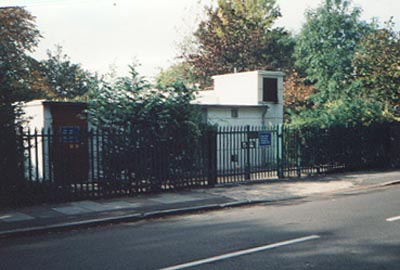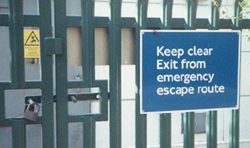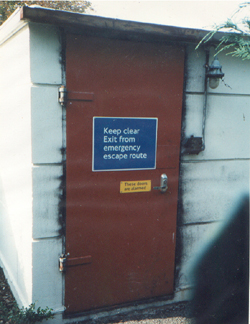



(Photos Copyright Roy Smith)
Situated between Hampstead and Golders Green on the Northern itís often called "The Station that Never Was" and at about 200 feet (61m) deep it would have been Londonís deepest Underground station. Usually called "Bull and Bush" by railway staff after the pub of music-hall fame, a quarter of a mile away.
The Charing Cross, Euston and Hampstead Railway began service to Golders Green in 1907. North End station-level tunnels and platforms had been completed but the lift-shafts to the surface were never excavated and no surface structures were started.
Hampstead Heath Protection Society, strength of opposition from local residents and possibly not enough projected passenger use caused the station project to be abandoned in 1906. The station platform surfaces were removed and replaced with wooden staging and the surface plot sold.
Prior to the Second World War, at a cost then of three quarters of a million pounds, 25 floodgates were constructed within the underground to prevent flooding. Much of the tube system would be put out of action should a bomb penetrate the lining under the Thames or should the Embankment be breached or a nearby sewer or water main be ruptured. During the Second World War the gates were controlled from Leicester Square Underground station.
In the Cold War of the1950ís the system was up-dated and the control-room moved to Bull and Bush in a specially constructed two storey control room 110 feet (34m) below ground accessed from the surface. The shaft was continued down to the train tunnel.
It controlled 20 automatic flood-gates that were known as "Special Tunnel Works" that lowered through gaps in the tunnel roofs at the turn of a switch.
Other flood gates were operated manually locally and their status was indicated on the control panel. Duncan Campbell in War Plan UK suggests that this is to prevent flood water entering the protective ring of central London and the tunnels can be used for transport, or more likely shelters during a nuclear attack. One of the war-time control panels used at Leicester Square was moved to Bull and Bush.
Today the status of the flood gates and the control room is unknown. The threat of flooding to London has been relieved by the Thames Barrier and the risk of nuclear attack has subsided. The shaft now is part of the LU emergency exit, rescue entrance and smoke ventilation plan of the Northern Line underground.
The station site is visible from passing trains, or on the video "Northern City, Driverís eye view", obtainable from The London Transport Museum, Covent Garden.
Between Hampstead and Golders Green stations.
"Not a Deep Shelter but a station that never was. Utilised as an
emergency HQ and later a flood warning control centre and now an emergency
exit and rescue entrance to the Northern Line underground. At 200 ft down,
London's deepest station was used in the 1950's as London Transport's emergency
headquarters in the event of a nuclear attack. Later it became the control
centre for the Underground's string of floodgates, built in the tunnels
running under central London, which would be lowered through gaps in the
tunnel roofs at the turn of a switch. Now abandoned, the Bull and Bush
features on London Transport's list of disused underground stations offered
for rent." (10)
See "Rails Through the Clay" by Jackson & Croome p388 for a good history of North End. North End.....Today, the station is abandoned and the platforms are gone, but the site is visible from passing trains. (11)
See p 217 of BtCS, 1983 edition for description of control room.
Photos:
Hampstead Way.




(Photos Copyright Roy Smith)
Reference sources:
"Rails Through the Clay" by Jackson & Croome p388 for a good history of North End.
"War Plan UK" by Duncan Campbell p256-260 1st edition for a very good account and illustration of the control panel.